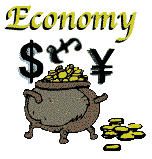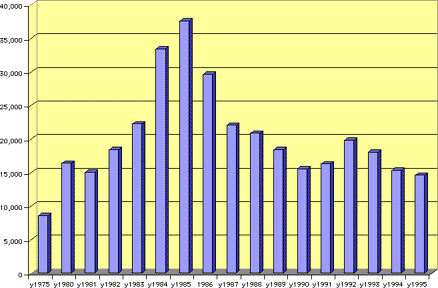|

QATAR
GDP (2008 est.): $116 billion.
Real growth rate (2008 est.): 11.2%.
Per capita income (2008 est.): $103,000.
Budget: Income .............. $40.36 Billion
Expenditure ... $28.08 Billion
Main Crops: Fruits, vegetables; poultry, dairy products, beef; fish .
Natural Resources:Petroleum, natural gas, fish .
Major Industries: Crude oil production and refining, fertilizers, petrochemicals, steel reinforcing bars, cement .
|
| NATIONAL GNP |
 |
Oil formed the cornerstone of Qatar's economy well into the 1990s and still accounts for more than 70% of total government revenue. In 1973, oil production and revenues increased sizably, moving Qatar out of the ranks of the world's poorest countries and providing it with one of the highest per capita incomes. Despite a marked decline in levels of oil production and prices since 1990, Qatar remains a wealthy country, thanks largely to burgeoning gas exports.
Qatar's economy was in a downturn from in the mid-1990s. The Organization of Petroleum Exporting Countries' quotas on crude oil production, the lower price for oil, and the generally unpromising outlook on international markets reduced oil earnings. In turn, the Qatari Government's spending plans had to be cut to match lower income. The resulting recessionary local business climate caused many firms to lay off expatriate staff. With the economy recovering in the late 1990s, expatriate populations, particularly from Egypt and South Asia, have grown again.
Oil production will not long return to peak levels of 500,000 barrels per day (b/d), as oil fields are projected to be mostly depleted by 2023. However, large natural gas reserves have been located off Qatar's northeast coast. Qatar's proved reserves of gas are the third-largest in the world, exceeding 7 trillion cubic meters and Qatar has the larges single gas field in the world. The economy was boosted in 1991 by completion of the $1.5-billion Phase I of North Field gas development. In 1996, the Qatar gas project began exporting liquefied natural gas (LNG) to Japan. Further phases of North Field gas development costing billions of dollars are in various stages of planning and development, and agreements have been concluded in 2000 and 2001 with U.A.E., Bahrain, and Kuwait to expand gas via pipelines and to Korea, India, and China via ship.
Qatar's heavy industrial projects, all based in Umm Said, include a refinery with a 50,000 b/d capacity, a fertilizer plant for urea and ammonia, a steel plant, and a petrochemical plant. All these industries use gas for fuel. Most are joint ventures between European and Japanese firms and the state-owned Qatar General Petroleum Corporation (QGPC). The U.S. is the major equipment supplier for Qatar's oil and gas industry, and U.S. companies are playing a major role in North Field gas development and related energy and water infrastructure development.
Qatar pursues a vigorous program of "Qatarization," under which all joint venture industries and government departments strive to move Qatari nationals into positions of greater authority. Growing numbers of foreign-educated Qataris, including many educated in the U.S., are returning home to assume key positions formerly occupied by expatriates. In order to control the influx of expatriate workers, Qatar has tightened the administration of its foreign manpower programs over the past several years. Security is the principal basis for Qatar's strict entry and immigration rules and regulations. |
|
|


